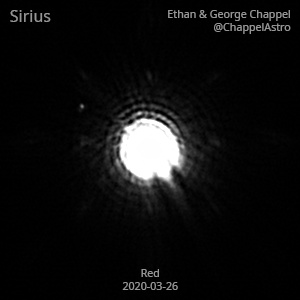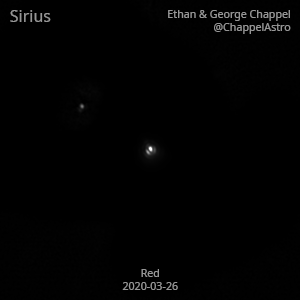

Sirius UTC
Description
After finishing with Venus, I decided to try something a little different by imaging a double star. The obvious candidate was Sirius with its bright A-type main sequence primary and dimmer white dwarf companion. Sirius B is slightly past its 31.5 AU apastron, similar to the distance between the Sun and Neptune. The stars will gradually close in until they are 8.2 AU apart at periastron in 2044.
Equipment
ZWO ASI290MM
Celestron EdgeHD 14
Logs
FireCapture v2.6 Settings ------------------------------------ Observer=Ethan Chappel Camera=ZWO ASI290MM Filter=R Profile=Venus Diameter=23.86" Magnitude=-4.37 FocalLength=300mm (F/1) Resolution=1.99" Filename=2020-03-26-0319_4-EC-R.ser Date=2020_03_26 Start=03_19_14.149 Mid=03_19_24.154 End=03_19_34.160 Start(UT)=03_19_14.149 Mid(UT)=03_19_24.154 End(UT)=03_19_34.160 Duration=20.011s Date_format=yyyy_MM_dd Time_format=HH_mm_ss LT=UT -6h Frames captured=1361 File type=SER Binning=no Bit depth=8bit Debayer=no ROI=436x418 ROI(Offset)=0x0 FPS (avg.)=68 Shutter=1.000ms Gain=0 (0%) Gamma=50 Brightness=1 (off) FPS=100 (off) AutoGain=off SoftwareGain=10 (off) USBTraffic=40 (off) AutoExposure=off AutoHisto=75 (off) HighSpeed=off Histogramm(min)=0 Histogramm(max)=106 Histogramm=41% Noise(avg.deviation)=0.00 AutoAlign=false PreFilter=none Limit=20 Seconds Sensor temperature=31.7°C Focuser position=2732 FireCapture v2.6 Settings ------------------------------------ Observer=Ethan Chappel Camera=ZWO ASI290MM Filter=R Profile=Venus Diameter=23.86" Magnitude=-4.37 FocalLength=3100mm (F/11) Resolution=0.19" Filename=2020-03-26-0315_9-EC-R.ser Date=2020_03_26 Start=03_15_44.528 Mid=03_15_54.534 End=03_16_04.540 Start(UT)=03_15_44.528 Mid(UT)=03_15_54.534 End(UT)=03_16_04.540 Duration=20.012s Date_format=yyyy_MM_dd Time_format=HH_mm_ss LT=UT -6h Frames captured=1362 File type=SER Binning=no Bit depth=8bit Debayer=no ROI=436x418 ROI(Offset)=0x0 FPS (avg.)=68 Shutter=5.640ms Gain=466 (77%) Gamma=50 Brightness=1 (off) FPS=100 (off) AutoGain=off SoftwareGain=10 (off) USBTraffic=40 (off) AutoExposure=off AutoHisto=75 (off) HighSpeed=off Histogramm(min)=0 Histogramm(max)=255 Histogramm=100% Noise(avg.deviation)=1.11 AutoAlign=false PreFilter=none Limit=20 Seconds Sensor temperature=32.1°C Focuser position=2732